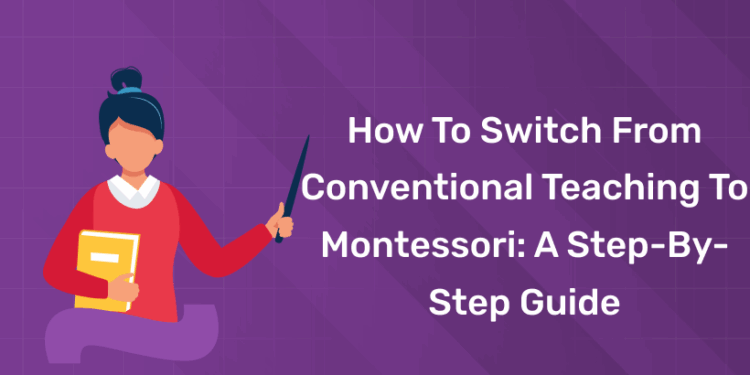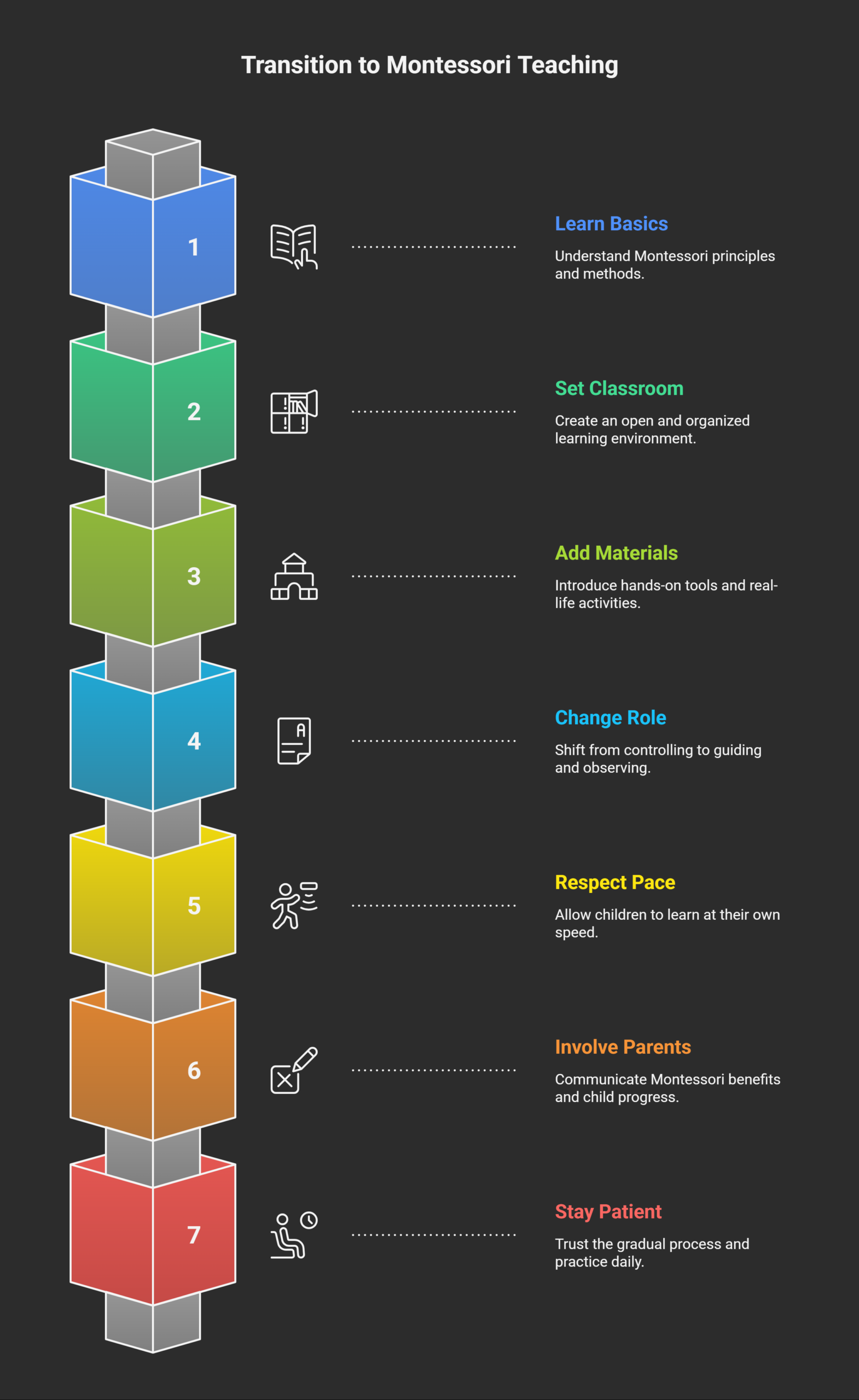Table of Contents
How to Switch from Conventional Teaching to Montessori is a common question today. We want to adopt modern learning methods. Montessori gives freedom, creativity, and hands-on experiences. It changes focus from lectures to self-directed approach. Students learn via curiosity instead of pressure or tests. Teachers guide students instead of controlling every step. This change makes learning joyful and more meaningful.
The transition is not always simple or quick. Teachers need patience and consistent practice during the shift. Parents may also need time to adjust perspectives. Montessori requires new materials and classroom organization methods. It is more about guidance than strict instruction. Over time, both teachers and kids adapt naturally. This results in a balanced, child-centered learning environment.
Key Takeaways
- Montessori allows children to learn by exploring.
- Teachers guide instead of taking lessons.
-
The switch needs time and patience.
-
Parents may need help to understand the system.
-
Classrooms need simple tools and open space.
-
Students grow more confident and independent.
Start your journey to becoming a certified Montessori teacher! Get free Demo Here!
Introduction
Moving from conventional teaching to Montessori can feel big. Many teachers worry about the change. But the switch is worth the effort. It makes learning calm, free, and child-friendly. Children learn by doing, not just by listening. Teachers guide instead of giving strict lessons. With small steps, the change becomes smooth.
Why the Switch Matters
Montessori is very different from normal teaching. It focuses on the child, not only marks. Children work at their own speed. Teachers help instead of control. This makes classrooms peaceful and active.
Key Features
-
Child-focused learning: Child picks tasks he/she like.
-
Teacher as guide: Teachers watch and support the kids.
-
Hands-on practice: Children learn by touching and trying.
-
Freedom with rules: Children can choose but have limits.
Benefits
-
Builds love for learning.
-
Helps children feel confident.
-
Reduces stress from tests.
-
Improves teacher-student bonds.
-
Makes classrooms calmer and focused.
Why Make the Switch to Montessori?
1: What is the primary focus of the first plane of development in the Montessori method?
Switching to Montessori helps teachers as well as the students. It gives a child-focused environment with freedom and responsibility. Children learn naturally without heavy stress or pressure. Teachers enjoy guiding instead of giving constant lectures. Parents see children becoming confident and independent. The system supports growth in both academics and life skills.
A Better Way of Learning
Montessori moves away from memorization and strict lessons. It helps children explore, think, and question. The focus is on overall growth, not only grades. Students enjoy learning and stay more motivated.
Key Reasons for the Switch
-
Child Independence
-
Children pick tasks they like.
-
Builds confidence and responsibility.
-
-
Hands-on Learning
-
Uses real objects and tools.
-
Children learn by doing, not memorizing.
-
-
Teacher’s New Role
-
Teacher becomes a guide and observer.
-
Less stress for both teacher and child.
-
-
Calm Environment
-
Classrooms feel peaceful and ordered.
-
Children work at their own speed.
-
Comparison Table
| Aspect | Conventional Teaching | Montessori Teaching |
|---|---|---|
| Teacher’s Role | Lecturer, controller | Guide, observer |
| Learning Style | Memorization, repetition | Hands-on, self-paced |
| Student Freedom | Limited choice | Wide choice with rules |
| Assessment | Tests and grades | Observation, progress notes |
| Classroom Setup | Rows of desks | Open space, learning areas |
Benefits for All
-
For Students: More freedom, confidence, and curiosity.
-
For Teachers: Less stress, more guiding role.
-
For Parents: Children learn life skills, not only facts.
-
For Schools: Calm, engaging, and creative classrooms.
Get Certified & Start Your Montessori Career
Montessori Teacher Training Course by Entri App: Gain expert skills, earn certification, and kickstart your teaching career.
Join Now!Key Differences Between Conventional and Montessori Teaching
Conventional and Montessori teaching are two different things. Conventional follows fixed lessons and strict control. Where as Montessori allows freedom, choice, and hands-on work. Teachers act as guides and not controllers. Children learn at their own speed. This makes Montessori calmer and more natural.
Main Differences
-
Teacher’s Role
-
Conventional: Teacher talks and controls.
-
Montessori: Teacher guides and observes.
-
-
Learning Style
-
Conventional: Focus on memorizing.
-
Montessori: Focus on doing and exploring.
-
-
Student Speed
-
Conventional: Same speed for all.
-
Montessori: Own speed for each child.
-
-
Assessment
-
Conventional: Tests and grades.
-
Montessori: Observations and notes.
-
-
Classroom Setup
-
Conventional: Desks in rows.
-
Montessori: Open space with activity areas.
-
Comparison Table
| Aspect | Conventional | Montessori |
|---|---|---|
| Teacher Role | Controller | Guide |
| Learning Style | Memorization | Hands-on |
| Student Pace | Fixed for all | Own pace |
| Assessment | Tests, grades | Observations |
| Classroom Look | Rows of desks | Open, flexible |
Why This Matters
Montessori creates more freedom for children. It reduces stress and pressure. Teachers feel less burdened too. Classrooms become active, peaceful, and joyful.
Start your journey to becoming a certified Montessori teacher! Get free Demo Here!
How to Switch from Conventional Teaching to Montessori: A Step-by-Step Guide
Switching to Montessori takes time and patience. Teachers should move slowly, step by step. Small changes in the classroom bring big results. The focus is on guiding, not controlling. Here are simple steps to make the change.
Step 1: Learn the Montessori Basics
-
Read about Montessori philosophy.
-
Understand freedom with limits.
-
Know the role of the guide.
Step 2: Prepare the Classroom
-
Remove rows of desks.
-
Create open spaces.
-
Add shelves for materials.
-
Keep things neat and simple.
Step 3: Use Montessori Materials
-
Start with basic practical tools.
-
Add math and language aids.
-
Use objects children can touch.
-
Let children work with real items.
Step 4: Change the Teacher’s Role
-
Observe more, talk less.
-
Guide when needed, not always.
-
Let children make choices.
-
Encourage independence daily.
Step 5: Adjust the Learning Pace
-
Do not rush children.
-
Allow different speeds.
-
Respect slow and fast learners.
-
Celebrate small progress.
Step 6: Involve Parents
-
Explain Montessori methods clearly.
-
Share progress through notes.
-
Show benefits with examples.
-
Answer parent questions calmly.
Step 7: Be Patient and Consistent
-
Accept small mistakes as learning.
-
Practice daily with children.
-
Stay calm with challenges.
-
Believe in the process.
Quick Overview Table
| Step | Action | Result |
|---|---|---|
| Learn Basics | Study Montessori philosophy | Teacher ready to guide |
| Prepare Classroom | Open space, shelves | Child-friendly environment |
| Use Materials | Add real tools, objects | Hands-on learning begins |
| Change Role | Guide, observe, support | Independence grows |
| Adjust Pace | Allow own speed | Calm and stress-free class |
| Involve Parents | Communicate benefits | Parent trust increases |
| Be Patient | Practice daily | Smooth transition achieved |
Common Challenges Teachers Face During the Switch
Switching from conventional teaching to Montessori is not always easy. Teachers face new roles, new tools, and new ideas. Parents also need time to accept the system. With patience, these challenges can be handled well.
Challenge 1: Changing the Teacher’s Role
-
Teachers find it hard to step back.
-
They want to control lessons.
-
Montessori needs more guidance, less control.
Challenge 2: Managing the Classroom
-
Open spaces feel messy at first.
-
Children move around more.
-
Teachers need new ways to keep order.
Challenge 3: Learning Montessori Materials
-
Materials look new and different.
-
Teachers need training to use them.
-
Practice makes handling easier over time.
Challenge 4: Handling Parent Concerns
-
Parents ask about no tests or grades.
-
They may fear less discipline.
-
Teachers must explain Montessori benefits clearly.
Challenge 5: Shift in Mindset
-
Teachers are used to control.
-
Montessori asks for patience.
-
Accepting freedom with limits takes time.
Quick Challenge Table
| Challenge | Why It Happens | How to Handle It |
|---|---|---|
| Role of teacher | Used to control | Practice guiding, observing |
| Classroom Order | Children move freely | Set simple ground rules |
| New Materials | Unfamiliar tools | Learn, train, practice |
| Parent Concerns | Fear of no tests | Explain, show progress |
| Mindset Shift | Hard to accept freedom | Stay patient and consistent |
Get Certified & Start Your Montessori Career
Montessori Teacher Training Course by Entri App: Gain expert skills, earn certification, and kickstart your teaching career.
Join Now!Conclusion
Moving from conventional teaching to Montessori requires time and effort. We must change roles, methods, and classroom setups. Parents need time to see the value. The process may feel slow in the beginning. But with patience, the change brings great results. Children become confident, curious, and independent learners. Teachers also enjoy less stress and more joy.
It is not only about academics but also life skills. It builds responsibility, respect, and love for learning. Teachers guide instead of controlling. This changes the mood of the classroom. Parents see children growing in many positive ways. Schools become calm, creative, and student-friendly places. The journey may be hard but worth it. With small steps, the switch becomes smooth and lasting.
Get Certified & Start Your Montessori Career
Montessori Teacher Training Course by Entri App: Gain expert skills, earn certification, and kickstart your teaching career.
Join Now!Frequently Asked Questions
Is Montessori teaching really different from conventional teaching?
Yes, Montessori is very different from conventional teaching. In a conventional classroom, teachers lead the lessons, give instructions, and expect all children to learn at the same pace. Learning is often measured through tests and grades, and memorization plays a big role. In Montessori, the child is at the center, and learning happens at their own speed. Teachers guide, observe, and support rather than control. The classroom is arranged with open spaces and materials, so children can move, choose activities, and learn through exploration. This shift creates independence, curiosity, and love for learning.
How do Montessori teachers guide instead of teaching directly?
Montessori teachers act as guides by watching and understanding each child’s needs. They do not lecture or push a fixed lesson plan. Instead, they introduce activities, demonstrate how to use materials, and step back to let the child explore. If a child struggles, the teacher quietly offers support without interrupting their learning flow. Teachers record progress through notes and observations rather than tests, which gives a clearer picture of growth. This guiding role makes children more confident, as they learn to solve problems on their own while knowing the teacher is always there for support.
Will children learn enough without tests or grades?
Yes, children can learn deeply even without formal tests or grades. Montessori focuses on building understanding, not just memorizing answers. Teachers observe progress daily, noticing how children handle tasks, solve problems, and improve over time. Learning is measured through growth, independence, and skill development rather than numbers on a paper. For example, a child learning math may use beads and blocks to truly understand counting and division. This practical method helps knowledge stay longer and feel more real. While there are no grades, parents get detailed reports showing both academic and personal growth.
What materials are used in Montessori classrooms, and why?
Montessori classrooms use special materials designed for hands-on learning. For math, children use beads, rods, and blocks to see and feel numbers. For language, they use sandpaper letters, movable alphabets, and word cards. For practical life, they use real tools like pitchers, spoons, brushes, and trays. These materials are self-correcting, which means the child can see mistakes and fix them without needing constant help. The aim is to let children explore concepts with their hands and senses, making learning natural and memorable. Unlike textbooks, these materials invite curiosity and creativity.
How can parents support Montessori learning at home?
Parents can support Montessori learning by creating a child-friendly environment at home. This includes giving children safe access to shelves, tools, and simple household activities. For example, allowing a child to pour their own water, arrange clothes, or set the table builds responsibility and confidence. Parents should encourage independence by letting children try tasks on their own, even if they make mistakes. At the same time, they should avoid comparing their child’s progress with others, since every child learns at a unique pace. Reading stories, exploring nature, and providing quiet work spaces are also ways to extend Montessori learning at home.
What challenges do teachers face when switching to Montessori?
Teachers face several challenges during the switch to Montessori. The biggest is changing their own mindset, because many are used to controlling lessons and giving instructions. Letting go of that control and trusting children to lead can feel difficult at first. Classroom management also feels different, since children move around freely instead of sitting in fixed rows. Teachers must also learn how to use Montessori materials effectively, which often requires special training. Another challenge is explaining Montessori to parents, since many expect traditional tests and grades. However, with practice, patience, and clear communication, teachers overcome these challenges and enjoy the benefits of the method.
Can Montessori work for older children, or is it only for preschool?
Montessori is not just for preschool; it can be applied to older children too. While many people know Montessori for early childhood, its principles extend into elementary and even secondary education. In higher levels, the materials change, but the philosophy stays the same—students work independently, explore projects, and learn by doing. For example, older children may work on research-based projects, experiments, or group discussions rather than memorizing textbooks. The system also prepares them for real-life challenges, teaching time management, responsibility, and teamwork. Montessori can be a lifelong learning method, not only a preschool approach.
How does Montessori handle discipline in the classroom?
Montessori handles discipline very differently from conventional teaching. Instead of punishments or rewards, it teaches self-discipline and natural consequences. Children are free to choose activities, but they also follow simple rules like respecting others, caring for materials, and finishing tasks. If a child misuses materials or disturbs others, the teacher calmly redirects them. Over time, children learn that freedom comes with responsibility. They understand limits not because of fear but because they see the impact of their actions. This way, discipline becomes an internal quality, not something forced from outside.
Is it expensive to set up a Montessori classroom?
Setting up a Montessori classroom may seem costly at first because of the special materials. Montessori materials are designed to be durable and reusable, which makes them a long-term investment. Schools or teachers may start small, adding practical life tools and basic math and language aids before expanding. The environment itself doesn’t need to be fancy—it just needs open shelves, simple furniture, and natural light. Parents and teachers can even make some materials at home with creativity, like counting beads or letter cards. Over time, the investment pays off, since the materials last for years and support deep learning.
What is the biggest benefit of switching to Montessori?
The biggest benefit is that Montessori creates confident, independent, and curious learners. Children grow up loving learning, instead of fearing tests or pressure. They learn life skills like problem-solving, self-discipline, and responsibility, which help in all areas of life. Teachers also enjoy their role more, since they spend less time controlling and more time supporting. Parents notice real changes in their child’s behavior, confidence, and interest in learning. Montessori builds not only strong academics but also strong character, making it one of the most rewarding teaching methods.













